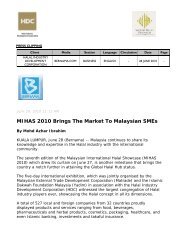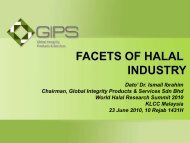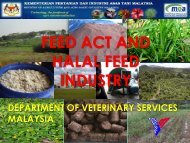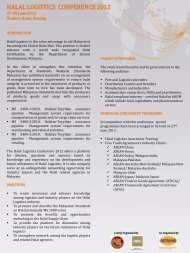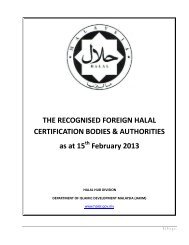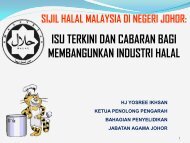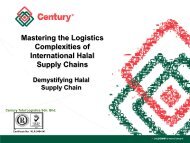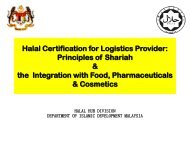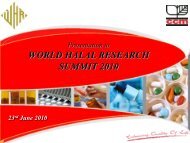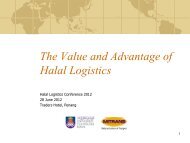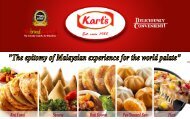Food - Halal Industry Development Corporation
Food - Halal Industry Development Corporation
Food - Halal Industry Development Corporation
Create successful ePaper yourself
Turn your PDF publications into a flip-book with our unique Google optimized e-Paper software.
UPDATES OF HALAL PRODUCTSAUTHENTICATIONYAAKOB B. CHE MAN & SHUHAIMI B. MUSTAFA<strong>Halal</strong> Products Research InstituteUniversiti Putra MalaysiaWorld <strong>Halal</strong> Research Summit 2010 ‘Inspiring Innovation Through Research’,23 – 25 June 2010, Kuala Lumpur, Malaysia
Presentation Outlines• Background• <strong>Halal</strong> Authentication and Certification• Global Challenges to <strong>Halal</strong> Analysis• Updates of R & D on Analytical Methods for<strong>Halal</strong> Products Authentication• Concluding Remarks
Background<strong>Halal</strong> from 2 perspectives :• Islamic perspective – <strong>Halal</strong> act and consumptionis an obligation to every Muslim. The opposite isharam which is prohibited activity• <strong>Industry</strong> perspective – ‘<strong>Halal</strong>an Thoyyiban’concept provides good business opportunitiesfor everyone, Muslims or non-Muslims alike
<strong>Halal</strong> – permissible based on shariah rulings(religious, faith and spiritual)Thoyyib – Good or Wholesome (quality, safety,hygeinic, clean, nutritious, quality, authentic -scientific))
Cont..In the selection of food and drink, and otherconsumer products, Islam has laid down 3very important guidelines:• Whether the consumption of the products are halal(permitted) or haram (prohibited) by Allah S.W.T.• Whether or not the materials are good and safe to beconsumed or used by mankind (thoyyib)• Whether the products are obtained through halal orharam means (e.g. source of finance)
<strong>Halal</strong> <strong>Industry</strong> Perspectives• <strong>Halal</strong> food, pharmaceutical, health products , medicaldevices, toiletaries and cosmetics worth USD 2.1trillion worldwide.• Lucrative industry and huge opportunities for halalbusiness - domestic and international trade• Demand for halal food and other Islamic consumergoods is increasing• Currently, ~1.8 – 2.0 billion Muslims
Organization of Islamic Countries (OIC)
The size of the Global <strong>Halal</strong> <strong>Food</strong> Market is projectedat more than USD 640 billion in 2010700Global <strong>Halal</strong> <strong>Food</strong> Market680660640USD620600Global <strong>Halal</strong> <strong>Food</strong>Market580560540Expon. (Global <strong>Halal</strong><strong>Food</strong> Market)5202004 2005 2009 2010 2012e 2015eSize of Global <strong>Halal</strong> <strong>Food</strong> Market (2004) : USD 587.2 billionGrowth : 1.5% per annumMarket size by 2010 : USD 641.5 billion10
Global <strong>Halal</strong> Market 2005 ~ US$3.1 trillion/year<strong>Food</strong>(US$ 0.58trillion)Non-<strong>Food</strong>(US$ 1.52trillion)Services(US$ 1.0trillion) Non-food Services <strong>Food</strong>Source : Third Industrial Master Plan11
MARKET FOR HALAL PRODUCTSPrimary meatProcessed food***& beverages****FMCG sectorPharmaceuticalNutraceuticalConfectioneryCosmetics &personal careBakery products• Approximately 67% ofpotentially <strong>Halal</strong> productsare categorized as fastmoving consumer goods(FMCG)• “Potentially halal” markethas been quantified as thetarget market that canpotentially be captured• <strong>Food</strong> FMCG and primarymeat together account for62% of the marketGlobal market for potentially <strong>Halal</strong>products, 2005** Percent
Cont…• <strong>Food</strong> industry globally are looking at the ‘ ’concept as a new tool for marketing• To tap this lucrative market, the industry mustunderstand and appreciate the religious and scientificbasis of halal requirement
Issues in <strong>Halal</strong> <strong>Industry</strong>• <strong>Halal</strong> concept is simple; however, the industry isbecoming more complex and sometimes confusing• Due to breathtaking technological development todayand the diversification of sources acquired globally forconsumer products processing andproduction, numerous number of processed productsare available in the market• It is very challenging and increasingly difficult forMuslims to ensure the halal status of products in themarket• This trend has raised concerns among Muslimconsumers regarding new processed food andconsumer products
<strong>Halal</strong> <strong>Food</strong> Suppy Chain‘From Farm to Plate’ Concept
<strong>Food</strong> Adulteration• Adulteration is an issue of major concern in thefood, cosmetics and pharmaceutical trade andindustries globally• Adulteration involving the replacement of high costingredients with lower grade and cheaper substitutes isa common phenomena in many these industries.• Adulteration of food products can be very attractive andlucrative for food manufacturers or raw materialsuppliers, e.g. recent melamine adulteration issue inbaby foods
Porcine-based Products Ingredients• Pork is commonly found in many food products• Lard could be effectively blended with other vegetableoils to produce shortening, margarines and otherspecialty food oils• In some countries, food manufacturers choose to blendvegetable fats with lard to reduce production cost• In other instances, adulteration with porcine productscould be unintentional, e.g. use of emulsifiers such asE-471 or mono- and diglyceride from lard
Pharmaceutical andMedical Products.•Capsules•Tablets and pastilles•Micro-encapsulation•Suppository•Gelatine sponge•Surgical powder•Gelatine dressing•Plasma substitutePRODUCTS<strong>Food</strong> products•Animal shortening•Calcium stearate•Gelatine•Lard•Pancreatin (pancreaticextract)•Pepsin•Sodium stearoyl lactylateOther Products•Brushes•Leather product•Shoes and sports shoes•Jackets•Wallets•Sling bags•Handbags
Examples of Haram Ingredients inCosmetics Placenta from human and animals Lard Gelatin and collagen (from pork or animal - notslaughtered according to Shariah law) Emulsifiers (from lard or animal fat - notslaughtered according to Shariah law) Enzymes (from non-halal sources) Hazardous chemicals/ingredients
<strong>Halal</strong> Authentication & Certification• <strong>Food</strong> (or any other products) is only halal if the entire valuechain, from farm to plate, is processed, handled and stored inaccordance to Shariah or <strong>Halal</strong> Standards and GuidelinesE.g - Malaysia Standard MS1500:2004 <strong>Halal</strong> <strong>Food</strong>:Preparation, Handling, Packaging and Storage - GeneralGuidelinesMalaysian Standard MS 2200:2008 Islamic ConsumerGoods Part 1: Cosmetic and Personal Care Products- General GuidelinesCodex Alimentarious – Codex General Guidelines for Useof the Term <strong>Halal</strong> (CAC GL-24/1997) – Secretariat ofthe Joint FAO/WHO <strong>Food</strong> Standard Programme originallybased on JAKIM’s Guidelines
<strong>Halal</strong> Standards in MalaysiaMS 1500:2004MS 1900:2005MS 2200:2008HALAL FOOD –PRODUCTION, PREPARATION, HANDLING ANDSTORAGE –GENERAL GUIDELINES (FIRST REVISION)QUALITY MANAGEMENT SYSTEMS - REQUIREMENTS FROM ISLAMICPERSPECTIVESISLAMIC CONSUMER GOODS - PART 1: COSMETIC AND PERSONALCARE - GENERAL GUIDELINES
HALAL CERTIFICATION PROCESS INMALAYSIAApplication/Document Approval/FeePremise Inspection /Audit /SampleReport WritingPanel CommitteeIssuance of <strong>Halal</strong> CertificateMonitoring and Enforcement /Sample
Global Challenges to <strong>Halal</strong>AnalysisMore stringent monitoring system is needed by<strong>Halal</strong> Authorities.Analytical techniques become a major challengefor authentication of halal productsReliable state-of-the-art scientific methods arerequired for analysis of non-halal components(e.g porcine origin) in halal productsCompetent scientists and scientific methods areneeded
Cont…Analysis should be able to reliably identify originof food componentsSensitive and robust enough to be applied tocomplex food/products matricesAnalysis based on certain identified biomarkers- oil/fat-based- protein-based- DNA-based- metabolites-based
Updates of R & D on AnalyticalMethods for <strong>Halal</strong> ProductsAuthentication
<strong>Food</strong> samples Issue Detectionlimit ofadulterantCake formulationFTIR SpectroscopyLard adulteration inshorteningReferences4% (w/w) level Syahariza et al. (2005)Chocolate Lard addition 3% (w/w) level Che Man et al. (2005)Biscuits Lard adulteration 4% (w/w) level Syahariza (2006)Edible oil Lard characterization NR Guillen and Cabo (1997)MeatLard mixed with othermeatNR Che Man et al. (2001)Meat Pork identification NR Al-Jowder et al. (1997)Animal FatsCod liver oilLard mixtureLard adulteration1% (w/w) levelNRJaswir et al. (2003);Rohman and Che Man(2010)GelatinDifferentiation of bovineand porcineNRRohman and Che Man(2009)Vegetable oilsLard adulteration1 %Hashim et al. (2010)
Liquid ChomatographyMethodsHPLC<strong>Food</strong>samplesMeat productsIssueDetection of porkand lardDetectionlimit ofadulterant1% in beef,3% in muttonReferencesSaeed et al., 1989Meat products Detection of lard 5% Rashood et al.,1995MeatEdible oilDetection of meatadulterationContamination oflard10% meat Wissiack et al.,2003NRMarikkar et al.,2005GelatineDifferentiation ofgelatine sourcesNRNorakasha et al.(2009)LC-MSAnimal fatsLard presenceNRDugo et al 2006
Gas ChromatographyMethods Issue <strong>Food</strong> samples Detection limit ofadulterantGC-FID Lard Animal fats(tallow andbuffalo)10% (in buffalo,5% in tallow)ReferencesFarag et al.(1983Vegetable oils 2% (w/w) lard Marikkar et al.(2005)GC-MS Pork Cooked meat NR Wittasinghe et al.(2001)GCxGC-MS-TOFLard Animal fats NR Chin et al. (2009)Animal fats NR Indrasti et al.(2010)
Electronic Nose<strong>Food</strong> samples Issue Detection limitof adulterantEdible oilDetection of lard1%ReferencesChe Man et al. (2005)MeatDetection of pork1%Juliana et al. (2010)Marina et al. (2010)Edible oil (VCO)Detection ofadulterationNR
Sunflower oilLard adulterationNRDifferential Scanning Calorimetry (DSC)<strong>Food</strong>samplesIssueDetection limit ofadulterantReferencesGhee, butter Adulteration of goat body fat 10% (w/w) level Lambelet, 1983Edible oilAdulteration of cow and buffaloghee by pigDetection of lard andrandomized lard in RBD palmoilDetection of lard andrandomized lard in RBD palmoilAdulteration of RBD palm oilwith lipase catalyzedinteresterified lard (ERLD)Detection of lard in selectedfood product deep fried in lardMonitoring lard, tallow andchicken fat adulteration inCanola oil10% (w/w) level Lambelet et al.,198010% (w/w) level Kowalski, 198910% (w/w) level Marrikar et al.,200110% (w/w) level Marrikar et al.,200210% (w/w) level Marrikar et al.,200310% (w/w) levelMarrikar et al.,2002
<strong>Food</strong>samples<strong>Food</strong>productsDNA Based MethodsIssueDetection limitof adulterantReferencesPork identification NR Che Man et al., 2007Meat Detection of pork and lard (qualitative) Aida et al., 2005Detection of pig derivatives Aida et al., 2007Pork adulteration 0.001 ng Che Man et al.(2008) PatentMeatCharacterization of porcine 10g/kg Chen et al., 1998muscle proteinDetection of pork meat NR Montiel-Sosa et al.,2000Detection of porkNRFadila et al (2010)Pork adulterationPork adulterationNR = not reported0.0001ngNRChe Man et.al (2010)PatentMurugaiah et al.(2009)
Enzyme-linked Immunosorbent Assay (ELISA)<strong>Food</strong>samplesIssueDetection limitof adulterantReferencesMeatproductsDetection of porkNRAyob et al., 1989Raw groundbeefpork adulteration1 %Martin et al.,1998Meat andfeedproductsPork quantification 0,5 – 0,05 % Chen and Hsieh,2000
HALAL PRODUCTSRESEARCH INSTITUTE
<strong>Development</strong> of Analytical Techniquesfor <strong>Halal</strong> Products Analysis in HPRI• Molecular Biology techniques (DNA, ELISA)• Fourier Transform Infrared (FTIR) spectroscopy• Electronic Nose (E-nose) technology• Differential Scanning Calorimetry (DSC)• Chromatography (e.g. GC-FID, GC-ToF-MS,HPLC, GCMS)• Biopotential Telemetry EEG & ECG
Molecular Biology Techniques(i) DNA-based technique• DNA technique is a favorite approach for speciesidentification because DNA is relatively stable evenafter processing• We develop method for species identification frompork samples using conventional and RT-PCRanalysis
Conventional PCRConventional PCRRFLPSpecies Specific
M A1 A2 A3 D1 D2 D3 K1 K2 P1 P2500 bp≈360 bp228 bp131 bpM-1Kb DNA ladderA1, A2 and A3- chicken sausages of different brandsD1, D2 and D3- beef sausages of different brandsK1 and K2- pork sausages of different brandsP1 and P2- unknown productsRestriction Enzyme Analysis of PCR AmplifiedCytochrome b Gene (sausages) (Che Man, et al 2005)
Real-time PCRReal-time PCRSYBR Green*UPM Patent** CommercialisedProducts - HaFYSTaqMan Probe*UPM PatentMolecular Beacon
BRIEF DESCRIPTION OF TECHNOLOGY(Description of Process)Total DNA ExtractionPrimers and probeDesignReal-time PCRSpecificity TestSensitivity Test40
SYBR Green Assay
Real-time PCRSpecificity test on pork primer designed againstother meat species (beef and chicken).
Real-time PCRSensitivity test of pork primer with 10-fold serial dilutionsDetection - 0.001ng of pork DNA. This is an essential discovery interms of <strong>Halal</strong> identification of food products
Specificity of the assayAmplification ofPorcine DNADNA of meat speciesother than porcineAmplification plot of porcine-specific TaqMan real time PCR assay on differentraw meat species. Note that only porcine DNA give rise to positive amplificationresembled by the increased of fluorescence intensity. Assay cross-testedagainst non-targeted meat species show no amplification which confirmed thespecificity conferred by the recent developed assay
Sensitivity of the assay0.0001ng/µLporcine DNAAmplification plot of porcine-specific TaqMan real time PCR assay on a serial 1:10 dilutedporcine DNA. It is showed that the ability of the assay to detect as low as 0.0001 ngporcine DNA in water. The high sensitive assay is important as a minute amount of pork infood products is prohibited for Muslim
Real-Time PCR <strong>Halal</strong> TestingMethods• The methods developed have the potential to be usedfor <strong>Halal</strong> authentication process.• The methods were highly sensitive and detected thepresence of 0.001ng (SYBR Green) and 0.0001ng(TaqMan) of pork template DNA when assessed usingdilutions of DNA in water.• These dedicated Real-Time PCR <strong>Halal</strong> TestingMethods developed which are rapid, specific andcheap offer huge market potential.
About the HaFYS TechnologyThe components of the system are:1. Portable real-time PCR analyzer2. Disposable Test module (lyophilized PCRreagents)3. DNA extraction kit (optional)
HaFYS - Portable PCR• Analyzer– Fully automated system for rapid DNA& RNA analyses– Sample preparation included– Simple one touch operation– Light weight and field deployable• Test Module– Pocket-sized, sealed cartridge(biohazard friendly)– Months to years storability at ambienttemperatures
Advantages of the HaFYS Technology1. Rapid (< I hour) and capable of multiplexing(optional)2. Portable (“Go Anywhere” - in the field or inthe lab)3. Easy to operate by unskilled operators4. Direct (w/o DNA extraction)/indirect (withDNA extraction) PCR testing5. Relatively cheap – affordable6. Reliable for animal speciation
Typical Real-Time PCR andHaFYS PCRSample TransportPreservative Temp TimeMedia Container etc.Nucleic Acid ExtractionDNA RNASample Source.RT-PCRRNA virusesTarget Amplification40-cyclesThermocycling ProcessTarget DetectionReal-time PCR or Gel4-48 hours 30-90 minutes 45-120 minutes 5 or 120 minutes30 minSpecimen CollectionMucous Swab SerumPlasma Blood CSFTissues Etc.Previously: A Complicated and Tedious ProcedureTaking 6-54 hours, Performed only in Special LaboratoriesStool and Plantprotocols underdevelopmentLess 1 Hour than or 30 Less minutesInsert Sample in ModuleGo Anywhere PCR LabTarget DetectionReal-time PCRReportable ResultsWith HaFYS : A Simplified ProcedureTaking About 1 Hour andDoable Anywhere, Indoors or Outdoors
Making the Complex Simple• Usual PCR = Many Steps = Hours to DaysTake Sample Transport Prep Sample PCR Results•HaFYS SimplicityOne Step, One Button, ~ One Hour− Collect Sample− Place in Test Module− Insert into Analyzer− One Button to Start− Yes/No Results− Easy, Fast, Anywhere
Red line: Internal control; blue line: beefsample (Negative Result)
Red line: Internal control; blue line:Cat food containing pork (Positive Result)
Red line: Internal control; blue line: notemplatecontrol
Unprecedented PCR Technology• Automatic Sample Preparation• Ruggedized Design (few moving parts)• Portable• Fully Automated Operation• Self-Contained Test Module• Novel Optical Detection• Rapid Results• Remote Communications -- Optional
Launching of HaFYS
FTIR SPECTROSCOPY
Fourier Transform Infrared (FTIR)Spectroscopy FTIR spectroscopy provides a highly effective choice. It is a fast and non-destructive technique, sensitive,and free of chemical preparation FTIR gives a valuable information about the presenceof molecular bonds or functional groups Using computer and its advance chemometricssoftware, FTIR can be easily manipulated the spectralinformation FTIR has been used for analysis of lard in mixed withbody fats of lamb, cow, and chicken; lard in cake andchocolate formulations as well as in cream cosmeticsformulations; diffrentiation of gelatin sources etc
FTIR SPECTRA OF LARD AND OTHER OILS
Peak identifications3007,1 cm -1 unsaturated CH2922 cm -1 CH 2 stretching2852,7 cm -1 CH 3 stretching1743 cm -1 carbonyl group (-C=O)1465 cm -1 CH 2bending1377,7 cm -1 CH 3bending1160,7 cm -1 overlapping CH 21117,3 and 1097 cm -1 oleic acid group962 cm -1 bending vibration of cis olefinic disubstituted721,7 cm -1 overlapping CH 2Sources: Pavia et al (2001); Guillen and Cabo (1997)
PCA OF LARD AND OTHER OILS1 = lard; 2 = beef fat; 3 = chicken fat; 4 = mutton fat; 5 = cod liver oil; 6 = canolaoil; 7 = corn oil; 8 = extra virgin olive oil; 9 grape seed oil; 10 = palm oil; 11 =pumpkin seed oil; 12 = rice bran oil; 13 = sesame oil; 14 = soybean oil; 15 =walnut oil; 16 = sunflower oil; 17 = virgin coconut oil
CLUSTER ANALYSIS OF LARD ANDOTHER OILS1 = lard; 2 = beef fat; 3 = chicken fat; 4 = mutton fat; 5 = cod liver oil; 6 = canolaoil; 7 = corn oil; 8 = extra virgin olive oil; 9 grape seed oil; 10 = palm oil; 11 =pumpkin seed oil; 12 = rice bran oil; 13 = sesame oil; 14 = soybean oil; 15 =walnut oil; 16 = sunflower oil; 17 = virgin coconut oil
Discriminant analysis of lard in mixture with body fats oflamb, cow, and chicken (Che Man, 2009)lard inmixture withLBFlard inmixture withCow-BFlard inmixture withCh-BF
1455.91338.91243.61562.21455.81338.21243.81633.81556.91633.91.8Differentiation of Gelatins (Hashim et al, 2010)1.61.41.21.00.80.6(1)0.40.20.0(2)-0.218001700160015001400130012001100Component peak location of FTIR for average of three spectra ofbovine gelatins (1) and average of three spectra of porcine gelatins (2).
Discriminant Analysis Plot for FTIR Analysis of GelatinCooman’s plot for two classes of gelatin: porcine gelatinand bovine gelatin.
Cont…• FTIR technique combined with chemometricanalysis was able to detect and quantify thelevel of lard adulterated in food samples• Fast and non- destructive technique, and freeof chemical preparation• Offers rapid (results in 2 min), simple, accurate,reliable, and environmental friendly technique
Electronic Nose
Raw /Processedmeats samplePrinciplecomponentanalysis(Datainterpretation)Electronic noseanalysisArray of electronic chemical sensors+Appropriate pattern recognition systemRecognizing odors
SAW detector response vs time. Pure RBD palm olein (pink)overlay with RBD palm olein adulterated with 5% lard (black)(Che Man et al, 2005)
Rapid Detection of Haram Meat (pork)by Electronic NoseVaporPrint TMPorkChickenBeefMuttonTypical chromatograms of four different types of meat.Pork showed more aromatic compound correspondingto the number of peaks.
VaporPrint TMCORN OIL PEANUT OIL PALM OLEINCOCONUT OILSESAME OILLARD
Statistical analysis (PCA)PORKBEEFCHICKENMUTTONThe different meat samples were separated along the first PC described 86%of the peak variation and showed four defined groups: beef and mutton withhigh positive scores; chicken meat with low positive score; and pork with highnegative scores along PC1.
Cont…• E-nose is an interesting alternative choice whichoffers easier operation, rapid determination (1min), and give reliable results• It is possible to detect any adulteration with thecharacteristic aroma fingerprint of each sample(1% detection level)• This electronic nose could fulfil the need for rapiddetection of lard adulteration in food
Differential Scanning Calorimetry
Differential ScanningCalorimetry• Thermoanalytical technique for monitoringchanges in physical or chemical properties ofmaterial by detecting heat changes• Thermogram profile show the presence of lardin food sample• Relatively simple, accurate and minimumamount of sample needed
DSC ThermogramA(GLD)A(0%)B(CRLD)B(1%)C(BT)D(MT)E(CF)C(2%)D(3%)E(4%)DSC cooling thermogram ofdifferent animal fatsDSC cooling thermogram of RBDPOadulterated with genuine lard(increasing proportion)Source: J.M.N. Marikkar et al. <strong>Food</strong> Chemistry, 76 (2002) 249–258
LARD PROFILE (Marikkar et al. 2001)ALDALD PROFILE (Sample Pre-Fried In Lard)AOOAOO PROFILE (Sample Pre-Fried In PalmOlein)Commercial Samples Profile
(ii) Protein-based technique• ELISA is used to determine the level of antibodiesin a sample and useful because they are specificand are relatively simple to perform.• We developed method for detection of pigderivatives qualitatively in the food samples usingELISA technique• The analysis yielded excellent results for detectionof pig derivatives in samples
A1- positive control;B1 and C1- negative controls;D1- mutton,E1- beef;F1- chicken meat,G1, H1, A2 and B2-pork;C2- mutton fat;D2- beef fat;E2- chicken fat;F2, G2, H2, A3- lard;B3, C3 and D3- chickensausages with differentbrands;ABCDEFGHELISA Results1 2 3 4 5E3, F3 and G3- beefsausages with differentbrands;H3 and A4- porksausages with differentbrands;B4 and C4- unknownsausages;D4, E4 and F4-unknown casings;G4, H4, A5 and B5-bread with differentbrands;C5 and D5- biscuitswith differentbrands; E5-homemade biscuitwith 1% lard;F5- homemadebiscuit with 50%lard;G5- homemadebiscuits with 100%lard.
Chromatography (GC)Gas chromatography (GC)High Performance liquidchromatography (HPLC)
GC-ToF-MS
Animal FAME – GC-FIDPigSheepCowChicken
Animal FAME - 2D (GC x GC)PigCowSheep
22242527 302823 262931
Lard FAME profiles and other animal fatsby GC×GC-TOF-MSFormulaC18:3 n3tFAME compoundMethyl trans-9,12,15-octadecatrienoateComposition (%)LA CA CF GF6.754 4.684nd nd ndC20:3 n3tMethyl 11,14,17-eicosatrienoate0.116 0.127 nd nd ndC20:2 n6Methyl 11,14-eicosadienoate0.268 0.030 nd nd nd
Conclusions• <strong>Halal</strong> and haram issues are serious matters for Muslimsbut also provide good business opportunities for everyone• Properly processed and halal certified consumer productsare pertinent to capture the lucrative global halal market• R & D and application of new methods for halal analysisand authentication is much needed to uphold thecredibility of halal certification programs• It is hoped that scientific advances on analyticaltechniques on halal products authentication wouldcontribute to the integrity of <strong>Halal</strong> certification and furthersupporting halal trade and industry
Acknowledgements• To all staff in HPRI, Universiti PutraMalaysia• Especially to our students & researchofficers• Abdul Rohman• Dias• Akasha• Juliana• Aida• Farihah• Fadhilah• Salwani• Salehan• Nazrim



